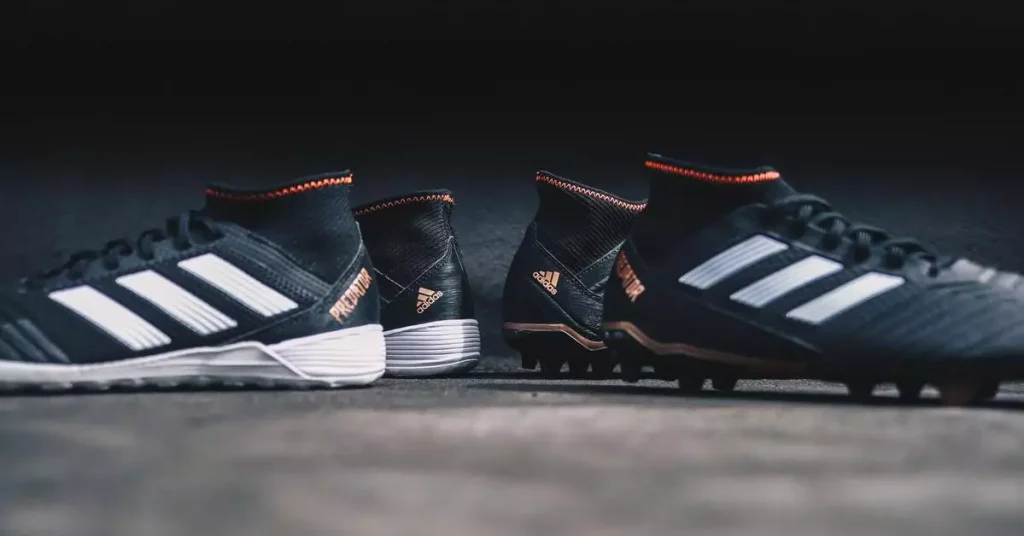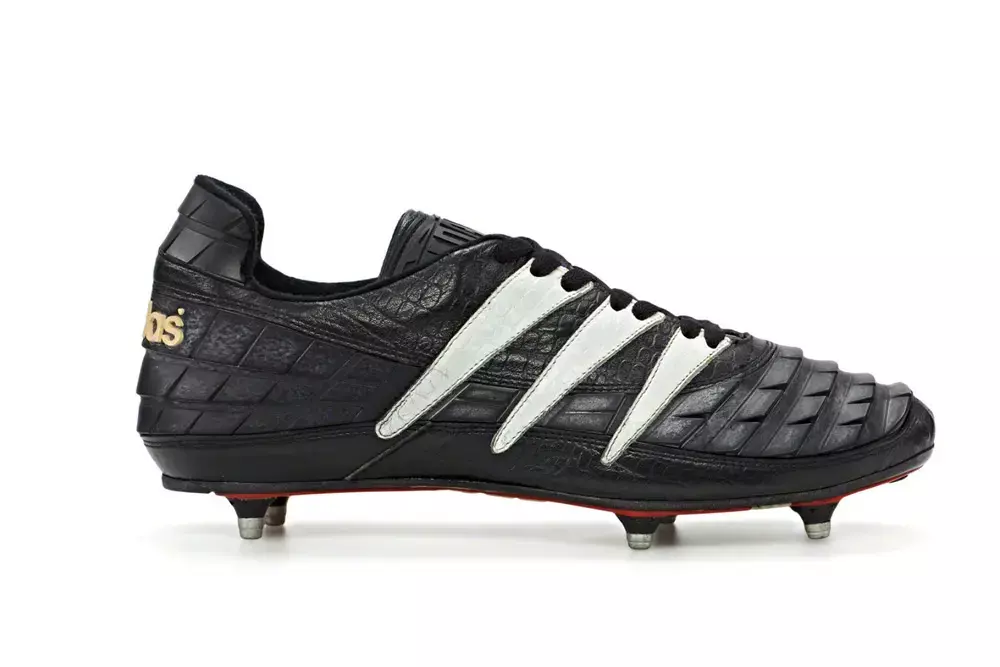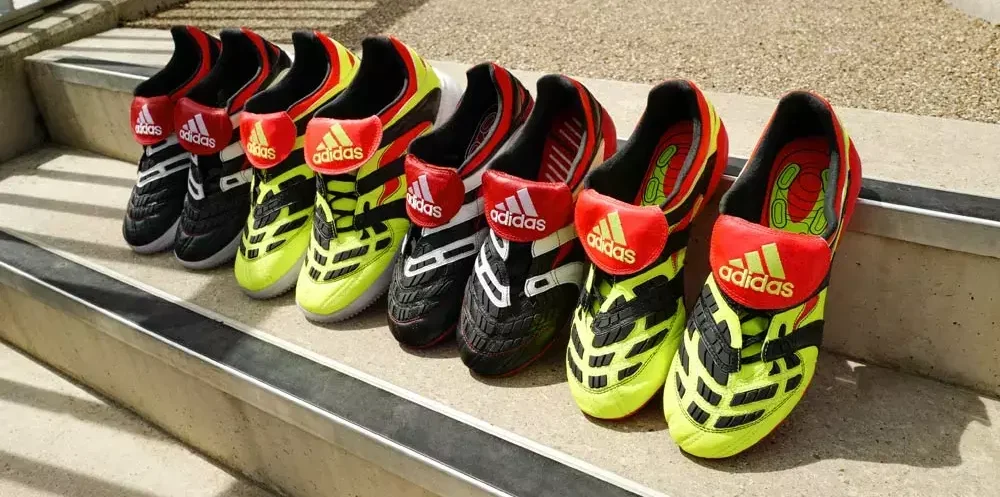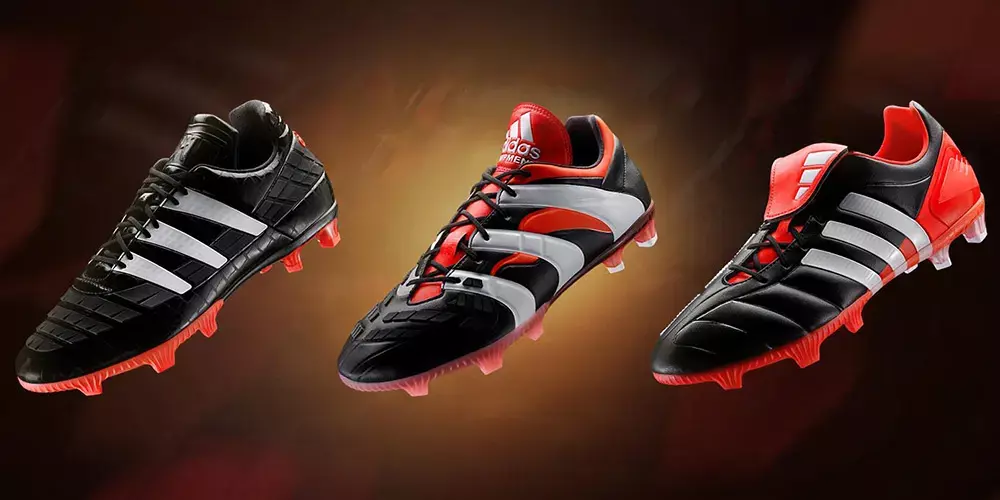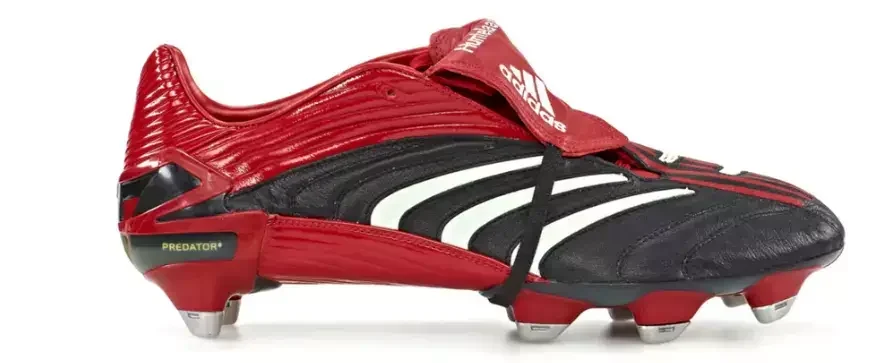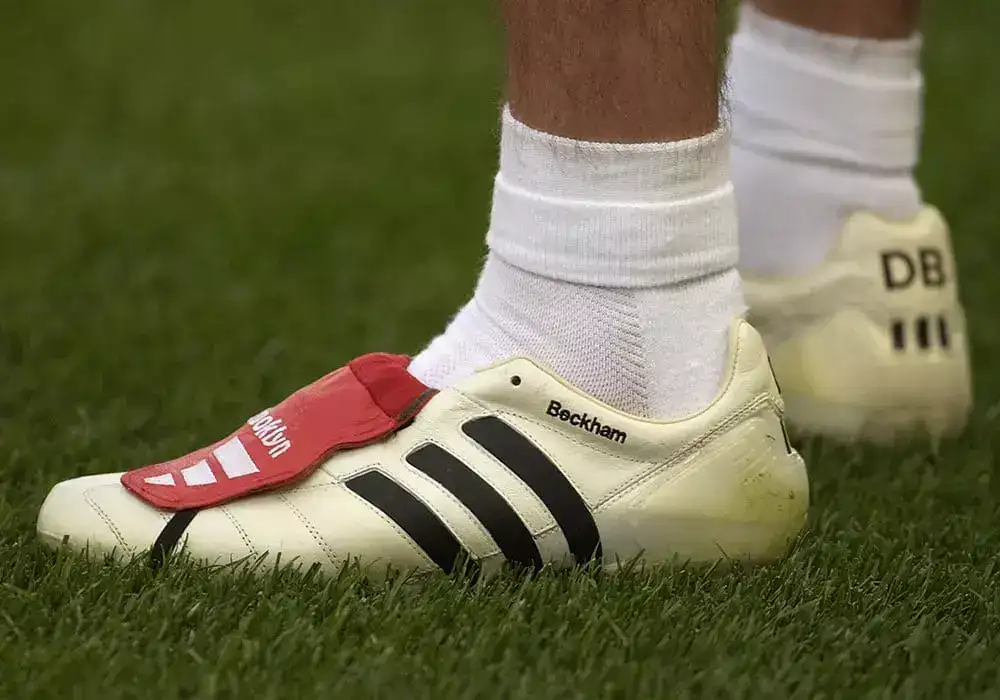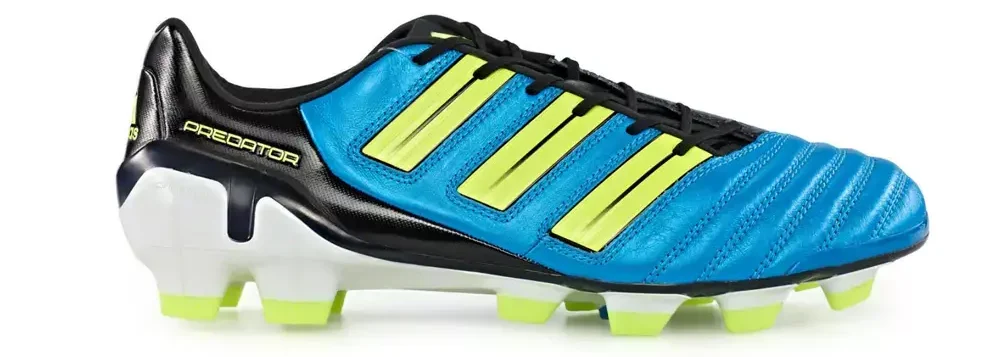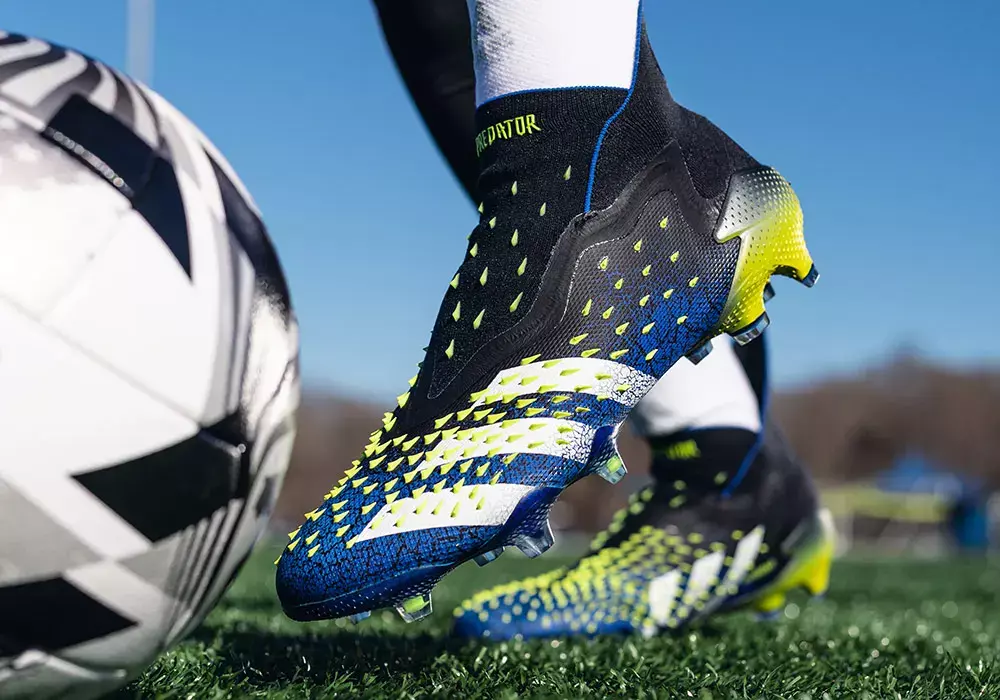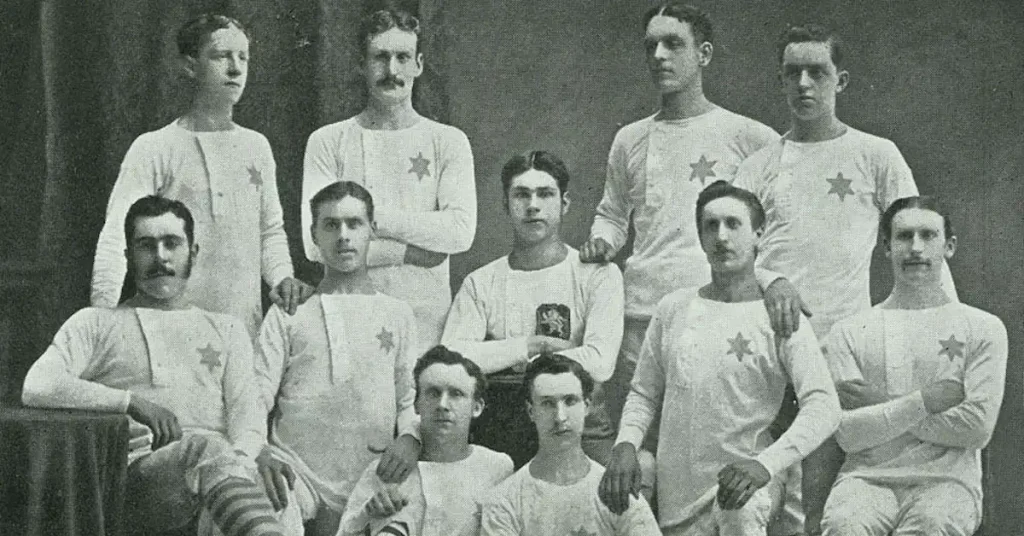Adidas Predator soccer cleats are the most popular and most successful soccer shoe in the history of the game. The original Adidas Predator boots were launched in 1994, and since then, the German manufacturer has released more than 20 variants of their popular cleats.
The Adidas Predator was manufactured based on a prototype developed by former Liverpool midfielder Craig Johnston. Hence, the Australian is credited as the mind behind the most successful cleats.
The Predator range of soccer cleats was discontinued in 2015 by Adidas, but it was relaunched in 2017. Adidas also has a separate range of Predator cleats for Rugby. This article will take an in-depth look at the evolution of the most famous soccer cleats.
Who Makes Predator Soccer Cleats?
The Predator soccer cleats range is owned and manufactured exclusively by Germany-based sportswear manufacturers Adidas. After developing an initial prototype, Craig Johnston presented it to various sportswear brands like Adidas, Puma, and Reebok.
However, his idea was shot down by all companies. However, Craig Johnston was adamant, and to convince Adidas, he sought help from various German internationals such as Franz Beckenbauer, Karl-Heinz Rummenigge, and Paul Breitner. Adidas finally decided to buy Johnston’s prototype, and it proved to be a masterstroke for them.
The first version of Adidas was established as Dassler Schuhfabrik (Dassler Brothers Shoe Factory) in 1924 by the Dassler brothers – Adolf and Rudolf. This company was more famous for developing and manufacturing athletic shoes rather than soccer shoes. Jesse Owens famously wore Dassler Brothers’ shoes when he won four Gold Medals at the 1936 Berlin Olympics.
However, the relationship between the two brothers turned sour, and the original company gave way to two of the most popular sportswear companies. Adolf founded Adidas in 1949, and Rudolf laid the foundations of Puma around the same time.
As international travel became standard after WW II, soccer gained global popularity. This development prompted sports companies to focus more on the sport, and Adidas became the leading innovator in the soccer wear industry.
In 1950, Adidas launched the first version of its Samba range. Adolf introduced screw-in studs that helped West Germany win the 1954 Soccer World Cup in rain-soaked conditions four years later.
What Year Did Adidas Predator Come Out?
The original Adidas Predator soccer cleats were launched in 1994 and changed the landscape of professional soccer. The original Adidas Predator featured rubber ridges on top of its uppers.
This new feature was added to enhance players’ ability to control and swerve the ball and provide extra power while hitting the soccer ball.
Adidas’ marketing strategy indicated that Adidas Predator soccer cleats would enhance the ball-controlling ability of even average players. In their marketing campaign, the Germany-based company described these soccer shoes as “100% legal, 0% fair”. Predators’ ads also claimed that they have 20% more swerve and 10% more power.
Soccer fans hadn’t seen this and witnessed such cleats before, and expectedly, the Adidas Predator launch created massive hype among soccer fans.
The original Adidas Predator soccer cleats were not cheap either, and they launched at a retail price of over £100 British pounds. However, despite their considerable price tag, the brand proved to be the most successful soccer cleats ever and brought in a massive amount of money for Adidas.
These soccer shoes are also considered one of the main reasons behind the turn in fortunes of Adidas, which was struggling financially during the early 90s’.
Who Designed The Adidas Predator?
Adidas Predator soccer cleats have an interesting story behind their inception. As mentioned earlier, former professional soccer player Craig Johnston is the mastermind behind these popular cleats.
The former Liverpool player came up with the idea of Adidas Predator while coaching a group of kids in his native Australia. Before Predators, most soccer cleats were made of leather, and they posed a few problems in wet and rainy conditions.
In one of his training sessions, Johnston taught his students how to put a spin on the ball and swerve it. Like table tennis players do with their bats. However, it was raining, and his students found it challenging to produce a curl with leather boots.
One of his students remarked that he can’t feel the soccer ball and that his soccer shoes surface is not made of rubber, as with table tennis bats.
Johnston had faced this problem on innumerable occasions in his career, but this time it gave him an idea. He went home and tied the rubber from the table tennis bat on top of the upper of one of his cleats with the help of an elastic band.
As expected, his make-shift pair of cleats seemed to do the trick. He was able to have greater control of the ball and produce a greater swerve. These cleats were also able to deliver greater power in shots, even in wet conditions.
From Patent To Prototype
Johnston’s next step was to patent his prototype. Following that, he took his prototype to Adidas, but his idea was rejected as the German company was struggling with bankruptcy at the time. He also reached out to other companies like Nike, Reebok, Umbro, and Asics, but he was met with the same response.
Between 1990-1992, Craig Johnston became busy with the Main Event’s TV show, but he kept working on his prototypes. After some time, Johnston picked up his idea and decided to approach Adidas again.
However, this time he decided to seek help from German players to convince the Germany-based sportswear company. He reached out to Franz Beckenbauer, who was the President of Bayern Munich at the time. The German great, also known as the King of German soccer, decided to test Johnston’s prototypes.
Beckenbauer also brought in other German greats such as Karl-Heinz Rummenigge, Gerd Mueller, and Paul Breitner. As these German greats tested his prototypes on a training ground, Johnston videoed them and recorded their opinions.
Later, Craig Johnston revealed that he couldn’t understand anything that the German players said, but it was evident that they liked his new prototypes. So he reached out to Adidas headquarters in Herzogenaurach, Germany, with the videotape.
He managed to convince the company’s new owner, French industrialist, Bernard Tapie, to look at the video. After taking a look at the tape, Adidas offered to buy Johnston’s prototype on the spot.
Johnston initially sealed a deal with Adidas in exchange for a 2% share of any future sales of the Adidas Predator. However, eventually, he was forced to sell his stake for a one-time payment.
Where Are Adidas Predators Made?
Adidas’ main headquarters is based in Herzogenaurach, Germany. However, the company outsources the majority of its production. According to Adidas’ official website, multiple ‘strategic suppliers’ handle Adidas products, including the Adidas Predator soccer cleats.
Most of these strategic suppliers are based in Far-East Asian countries, with Indonesia leading the charge. This has been the case for the last couple of decades. Hence, most Adidas Predator Soccer Cleats are manufactured in Indonesia.
Adidas has also manufactured the famous Predator boots at its Germany-based production facility. However, these cleats are mostly custom-made for professional soccer players or high-end customers.
The Evolution Of The Predator Soccer Cleat
The original Adidas Predator soccer cleats were made of kangaroo leather and featured rubber ridges. These cleats were black with white stripes and red accents. These boots became a cash cow for Adidas, and just a year later, the German company launched another model called Adidas Predator Rapier.
These were the first Adidas soccer cleats to be available in multiple color schemes. Before these cleats, all Adidas cleats were made of black leather. These cleats also featured a larger tongue.
In 1996, Adidas launched Predator Touch. These soccer shoes featured new Traxion studs, which were rectangular rather than round in shape. These cleats also featured smaller laces so that the fold-over tongue completely covered the laces, providing a greater striking area.
The next iteration was Adidas Predator Accelerator cleats. The cleats were launched in 1998 – the year of the FIFA World Cup in France. Adidas took a couple of years to develop these cleats and introduced several new features.
These cleats featured a newly developed TRX (Traxion) outsole and a “feet you wear” insole. These soccer boots also incorporated asymmetrical lacing, which provided a greater striking area for players. In addition, the cleats’ tongues had a rubber band that could be hooked to keep the tongue down.
Predator Accelerator is one of the most popular cleats in the Adidas Predator range. These cleats were launched in four different color schemes.
Adidas Predator Precision
Adidas launched Predator Precision cleats in 2000. These soccer shoes featured interchangeable Traxion studs and Velcro attached to their tongue.
The next in the line was Predator Mania cleats, launched in 2002. It was the World Cup year once again, and the soccer tournament was held in Asia for the first time. These cleats were designed based on a Far-East theme.
Predator Mania proved to be a massive hit among soccer fans. England superstar David Beckham famously wore these boots in champagne-white color.
The next Predator model was Pulse which was launched in 2004. These cleats featured a new technology called ‘PowerPulse.’ This technology supposedly shifted the cleat’s center of gravity closer to the point of impact with the ball.
Ahead of the 2006 World Cup, Adidas launched Predator Absolute. These cleats also incorporated the ‘PowerPulse’ system and featured exchangeable sock liners.
Adidas Predator Powerswerve
For their next Adidas Predator cleat, the footwear giant worked with French star Zinedine Zidane. Following his retirement from soccer, Zidane helped in the development of Predator Powerswerve, launched in 2008. These new designed boots featured ‘smartfoam’ instead of rubber ridges. This foam material provided more power and ball control to players.
Towards the end of 2009, the brand launched Predator X cleats. These cleats featured a new upper material called Taurus leather. These cleats also featured a new technology called Powerspine, and these were also the first Predator cleats to remove the tongue.
2011 saw the launch of AdiPower Predators. These cleats featured a SprintFrame outsole which significantly reduced the weight of Predator cleats.
Next year, Adidas Predator LZ was launched. LZ was short for ‘lethal zones.’ These cleats featured had five different lethal zones, which provided greater power when shooting for a goal and control over the soccer ball.
Adidas Predator Instinct
Adidas Predator Instinct was launched in 2014. These boots incorporated a new system called HybridTouch.
For the next few years, Adidas discontinued the Predator range and replaced it with their Ace range. However, the Adidas Predator made a comeback in November 2017 in the form of Predator 18. These boots had multiple features such as ControlSkin grip, Primeknit sock-fit collar, and ControlFrame outsole. This model was also the first laceless Predator cleats.
Following the release of Predator 18, Adidas has also launched Predator 19, and Adidas Predator 20. The most recent model is Predator Freak, which was launched in early 2021.
Famous Soccer Players To Wear The Predator Boot
Over the years, some major international soccer superstars have donned Predator cleats. However, John Collins was the first player to soccer a goal from Adidas Predator soccer cleats at top-level soccer. He scored from a free kick in a 1-1 draw with archrivals Rangers in April 1994.
David Beckham was wearing Adidas Predator Touch when he famously scored from the half-line against Wimbledon. He was wearing Adidas Predator Precision when he scored from the extra-time free-kick against Greece to send the Three Lions to the 2002 World Cup. The former England star donned the Predators for most of his career.
Zinedine Zidane is another megastar who wore Predator for most of his career. The Frenchman donned Adidas Predators in two World Cup finals – 1998 and 2006. Italian star Alessandro del Piero wore the Adidas Predator in the 1998 and 2002 World Cups.
Multiple stars such as Xavi, Robin van Persie, Steven Gerrard, Michael Ballack, N’Golo Kante, Raúl, Dirk Kuyt, Kolo Touré, Edwin van der Sar, Petr Čech, Brad Friedel, Anderson, Paul Pogba, and Eiður Guðjohnsen promoted the Adidas Predator X cleats when they came out in 2010. In addition, the likes of Kaka and Nani wore the adiPower Predators.
For their Predator LZ cleats, Adidas roped in several more stars such as Pepe Reina, Fernando Torres, Oscar, Aaron Ramsey, Mesut Özil, Per Mertesacker, Ángel Di María, Xabi Alonso, Pul Pogba and Juan Mata.
Adidas Predator Indoor Soccer Shoes
Due to the success since the first turf Predators was released in 1994, Adidas has introduced an indoor soccer range that is suitable for hardwood floors and artificial turf. The soles on these soccer cleats are flatter than turf boots as they require excellent grip.
Adidas Predator indoor soccer shoes have a flat, grippy outsole made for quick moves and turns and the speed of the indoor game is much quicker than playing on natural turf soccer fields.
Adidas even modified their Samba shoe to make it suitable for Sepak Takraw, an enormously popular soccer variation sport played in Asia.
